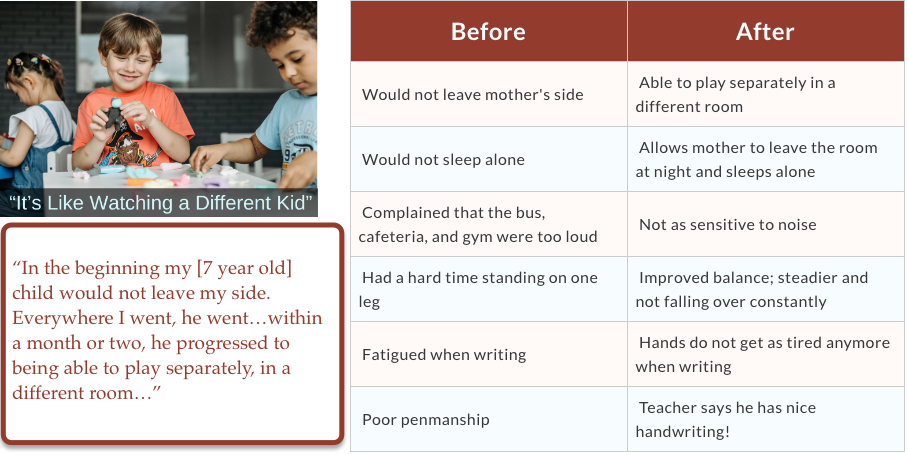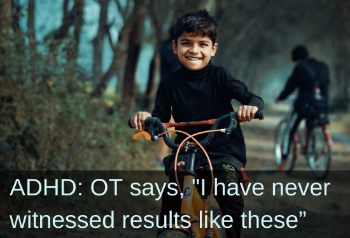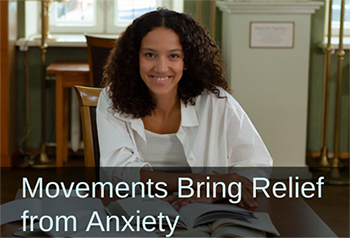Is there a connection between anxiety, sensory processing disorders, and retained primitive reflexes? Though these may seem like separate topics, sensory disorders and anxiety are related. Sensory processing disorders (SPD) impact how individuals respond to daily events and often co-occur with challenges such as emotional dysregulation and anxiety (McMahon et al., 2019). Retained primitive reflexes are associated with both sensory processing challenges (Pecuch et al., 2020) and with anxiety (Carter, 2020; Forrest, 2002).
One sensory system that is commonly challenged in cases of anxiety is the balance system. Since the balance system relies on movements to develop properly, is it possible that using movements to improve balance can also help reduce anxiety? That was the exact finding of Bart et al. (2009) who studied a group of children with anxiety. Bart et al., (2009) used a sensory-motor intervention for improving balance, which had the effect of lowering the children’s anxiety and boosting their self-esteem.
Researchers have found that movements for integrating primitive reflexes resulted in better balance for school-age children (Jeong et al., 2021; Grzywniak, 2017; Wahlberg & Diamond, 2005). Better balance and less anxiety can lead to improvements in social, emotional, and learning skills. For example, a 7 year old boy was so anxious he would not let his mother out of his sight and he refused to sleep alone. His mom joined the Brain and Sensory Foundations, First Level course and within two months, the boy experienced a major turnaround, as shown in the Before and After table here.
Notice that as this boy's balance improved, his anxiety diminished. At the same time, he became less sensitive to loud noises and his academic skills improved—all of these changes began soon after he received the innate rhythmic movements, primitive reflex integration, and the unique integrative movements from the Brain and Sensory Foundations course.
Another reason that neurodevelopmental movements are calming is because they help to mature the Moro reflex, and other primitive reflexes related to states of fight or flight. When the Moro reflex is unintegrated, there are often challenges with hypersensitivities and anxiety (Goddard, 2023). By integrating the Moro reflex, we have more maturity in the nervous system and the ability to be free from fight-or-flight-anxiety states.
Witness how neurodevelopmental movements helped these individuals release major stress and anxiety. What a relief for these individuals!
Six months made a huge difference for an 11-year-old girl who had been pulled out of school because of her chronic anxiety. She is now back in school and enjoying it—plus, she has seen a big jump in test scores! Learn how primitive reflex integration addressed her anxiety and helped her improve academic performance.
Anxiety and fears diminished and self-confidence improved for this 11-year-old girl! See how movements from the Brain and Sensory Foundations primitive reflex integration course helped this teenager with complex trauma overcome fears.
In 2 months, this boy's OT saw “profound improvements across multiple functional areas.” Read the case study to see how rhythmic movements and primitive reflex integration helped with issues like poor attention, picky eating, poor sleep, impatience, frequent anger, and fine- and gross-motor skills.
This 25-year-old struggled with panic, anxiety, and strength building. See how her OT used primitive reflex integration tools to help with panic attacks, anxiety, sleep, and her core strength.
References
Bart, O., Bar-Haim, Y., Weizman, E., Levin, M., Sadeh, A., & Mintz, M. (2009). Balance treatment ameliorates anxiety and increases self-esteem in children with comorbid anxiety and balance disorder. Research in Developmental Disabilities, 30(3), 486-495.
Carter, T. L. (2020). An exploration of the relationship between unintegrated primitive reflexes and symptoms of anxiety in children between 10-13 years in the Western Cape Province of South Africa [Doctoral dissertation. University of South Africa].
Forrest, D. S. (2002). Prevalence of retained primitive reflexes in patients with anxiety disorders. [Doctoral Dissertation, Annexe Thesis Digitisation Project 2017 Block 16.]
Goddard Blythe, S. (2023). Reflexes, movement, learning & behavior. Analysing and unblocking neuro-motor immaturity. Hawthorn Press.
Grzywniak, C. (2017). Integration exercise programme for children with learning difficulties who have preserved vestigial primitive reflexes. Acta Neuropsychologica, 15, 241-256.
Jeong, J. U., Choi, H., & Hahm, S. C. (2021). Effects of primitive reflex integration exercises on forward head posture, balance, and concentration in children with neurodevelopmental disability: a pilot study. Journal of The Korean Society of Integrative Medicine, 9(4), 29-38.
McMahon, K., Anand, D., Morris-Jones, M., & Rosenthal, M. Z. (2019). A path from childhood sensory processing disorder to anxiety disorders: The mediating role of emotion dysregulation and adult sensory processing disorder symptoms. Frontiers in Integrative Neuroscience, 22.
Pecuch, A., Gieysztor, E., Telenga, M., Wolańska, E., Kowal, M., & Paprocka-Borowicz, M. (2020). Primitive reflex activity in relation to the sensory profile in healthy preschool children. International Journal of Environmental Research and Public Health, 17(21).
Walhberg, T., & Ireland, D. (2005). Can replicating primary reflex movements improve reading ability? Optometry & Vision Development, 36(2).
Sonia Story, MS has been teaching neurodevelopmental movements since 2006.
She is an honors graduate with a Bachelor's degree in biology/psychology and a Master’s degree in Movement Sciences.
Sonia developed the Brain and Sensory Foundations program to provide comprehensive training in neurodevelopmental movements—combining innate rhythmic movements, play, primitive reflexes, and postural reflexes.
She is the author of The Importance of Reflex Integration and the Evidence eBook, giving the rationale and evidence basis for using neurodevelopmental movements for helping with challenges such as ADHD, Sensory Processing Disorders, anxiety, emotional dysregulation, visual skill deficits, poor social skills, gross and fine motor delays and other neurodevelopmental and behavioral disorders.
Her work is featured in numerous podcasts, summits, and conferences, and in the books Almost Autism: Recovering Children from Sensory Processing Disorder; Special Ed Mom Survival Guide; Family Health Revolution; and Same Journey, Different Paths—Stories of Auditory Processing Disorder.
Sonia’s mission is to help children and families experience the profound benefits of neurodevelopmental and integrative movements for more functional and fulfilling lives.







